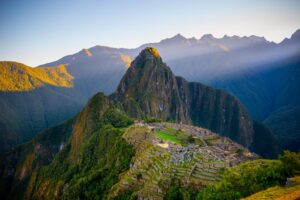
I have recently returned from a two-week trip to Peru that began in Lima – founded in 1535 by the Spanish conquistador, Francisco Pizarro – and ended in the depths of the Amazon rainforest. Checking out of my seaside mansion (now the fabulous B Arts Boutique Hotel) in the bohemian district of Barranco, I flew south to the ‘white city’ of Arequipa to explore the Santa Catalina Monastery, built in 1579 and home to the nuns of the Dominican Second Order.
Breakfast the following morning was adobo Arequipeño, a tasty local dish of marinated pork and just the fuel for the long road journey to the Colca Canyon. At 3,000 metres, Colca is one of the world’s deepest river gorges. It is also the place to see the majestic Andean condor as they wheel high above the valley floor. And, as a follow on to the marinated pork, I was given another local delicacy to try…grilled alpaca! I continued overland across the high plateau of the Peruvian altiplano to Lake Titicaca, the highest navigable lake in the world from where the Inca god Viracocha arose to create the Earth. It had been another long road journey, but I was up early the next day to meet the indigenous Uros, an ancient people who live on artificial floating islands built from the reeds that grow around the edge of the lake.
I then boated across Titicaca’s vast sheet of cobalt blue water to the beautiful island of Taquile, where unusually the islanders speak Quechua rather than Aymara. From Puno, I took the slow train north to Cusco and savoured the spectacular Andean scenery, together with a Pisco Sour or two! The historic capital of the Inca Empire is of course is a delight to explore, with any number of attractions, but I was particularly impressed by the ancient Sun Temple of Coricancha, whose floors and walls were once covered in sheets of gold, and the replica painting of ‘The Last Supper’ in the city’s main cathedral. The Peruvian version of Da Vinci’s iconic masterpiece has Christ and his disciples seated around a platter of cuy or guinea pig, a local Andean delicacy.
On next to the Sacred Valley and the Tambo del Inka Hotel, which had amazing views over the River Urubamba and was the perfect base for exploring the Inca ruins at Chinchero and Moray as well as the Maras salt mines. Time was not on my side, so I reluctantly eschewed the four-day Inca Trail to Machu Picchu for the train and bus option via Aguas Calientes and probably saved my knees in the process! By whatever means you reach Machu Picchu, it is always a ‘time stood still’ moment when you first set eyes on the Incas’ legendary mountain-top citadel. I had done so a few years back, but it was as magical as ever second time around. Now one of the world’s seven wonders, Machu Picchu is simply too special to rush, so I spent the night down at Aguas Calientes and returned the next morning to climb Huayna Picchu, the sugarloaf mountain that rises directly above the ruins and has the most incredible views from its summit. Returning to Cusco by train, the final leg of my journey took me east to the Peruvian Amazon and the Madre de Dios River. I stayed here at the riverside Inkaterra Reserva Amazonica, comfortable enough and an excellent base for exploring the rainforest and learning something about its natural riches. Wildlife is not easy to find, given the density of the jungle, but I was lucky enough to spot howler monkey, caiman, agouti and hoatzin as well as a myriad of other bird species. A fascinating and educational end to my journey through Peru.
View The Ultimate Travel Company’s Peru holidays.